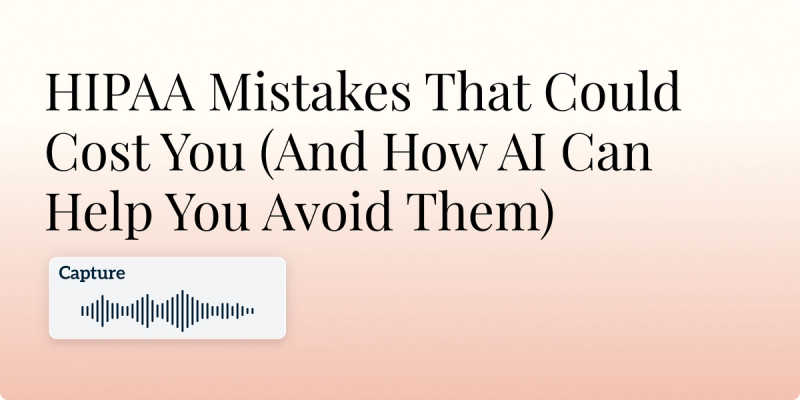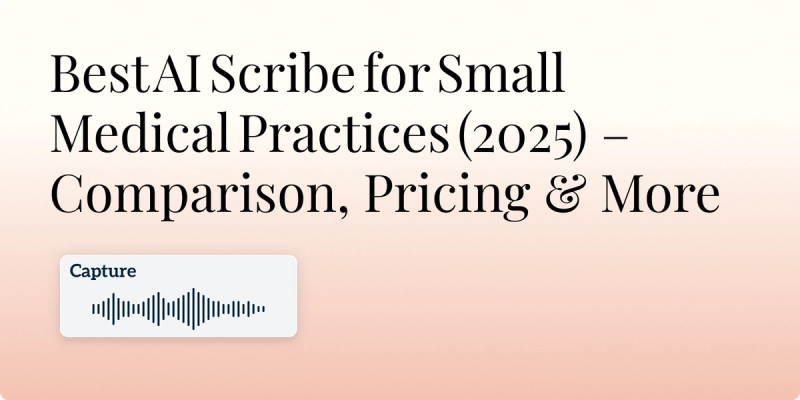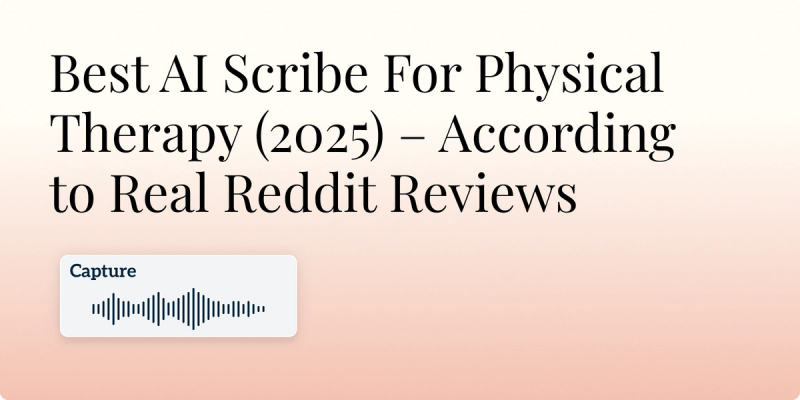
AI Notes for Therapists - What You Should Know in 2025

Key Takeaways
- Therapists Are Drowning in Paperwork: AI-powered note-taking tools are saving clinicians 12–15 hours a month by speeding up documentation and reducing burnout.
- Better Notes, Fewer Denials: These tools help therapists produce clean, time-stamped, and code-ready notes that improve claim approval rates and protect revenue.
- Smart Features Are the Norm Now: Expect built-in tools like multi-speaker transcription, emotion tracking, ICD-10 prompts, and HIPAA-ready security as table stakes.
- It’s Not Plug-and-Play: Clinics need training, clear workflows, and regular audits to safely use AI notes while staying compliant and clinically accurate.
- Worth the Investment: Most platforms offer up to 8x ROI by saving time and boosting billing efficiency, even after accounting for subscription costs.
Feeling buried by paperwork? You’re not alone. Between progress notes, treatment‑plan updates, and ever‑tightening payer rules, documentation can devour the hours you meant to spend with clients—or with your family. The good news: 2025 is the year AI‑powered note‑taking finally moves from “cool demo” to everyday clinical essential. In this guide, you’ll see how the latest platforms slash admin time, keep you HIPAA‑secure, and even surface clinical insights you might have missed ‑ all without sacrificing your professional voice.
Why AI Therapy Notes Matter in 2025
- Clinical Burnout Antidote: A 2024 APA survey found that 57 % of mental-health clinicians cite “documentation overload” as their #1 burnout driver. Practices using AI scribes report reclaiming 12–15 hours/month—time they now spend on supervision, self-care, or extra billable sessions.
- Revenue Protection: Payer audits rose 32 % last year following CMS’s risk-adjustment overhaul. AI-generated, time-stamped SOAP/DAP notes standardize terminology and add coding prompts that reduce claim denials by up to 18 %.
- Teletherapy Normalization: Roughly 4 in 10 therapy sessions remain virtual. Modern ASR (automatic speech recognition) now hits 97 %+ word-level accuracy, even with laggy Wi-Fi or multi-speaker overlap, capturing content older tools routinely missed.
- Data-Driven Care: Sentiment analysis and keyword heatmaps help clinicians spot themes—e.g., sleep hygiene, relapse triggers—that might otherwise stay buried in raw transcripts. Over time, these insights feed into individualized treatment-plan tweaks.

How the AI Technology Works
- Advanced Speech-to-Text: Uses domain-specific acoustic models (mental-health lexicons, DSM-5 terms) for fewer mis-transcribes like dialectical → diabolical.
- Generative NLP: Transformers summarize transcripts into client-friendly progress notes or clinician-centric SOAP/DAP formats, complete with section headers and time stamps.
- Clinical Coding Layer: Fine-tuned LLMs cross-reference symptom language against ICD-10/HCC libraries, suggesting likely codes (e.g., F32.9 Major depressive disorder, unspecified) plus documentation hints (“include functional impairment example”).
- Real-Time Quality Gates: Rule-based validators flag jargon (“client lost his ****”) or missing billable elements (duration, modality) before you sign.
- Seamless Integration:
- FHIR API push into major EHRs (TheraNest, SimplePractice, AthenaOne).
- Browser extension overlay for niche cloud EHRs without open APIs.
- SFTP / HL7 export for on-prem legacy systems.
AI Notes Must-Have Features in 2025
Feature | Why It Matters |
|---|---|
HIPAA, BAA | Protects PHI; many payers now require vendors to show HIPAA reports in credentialing packets. |
Multi-Speaker Separation | Couples, family, or group therapy transcription stays accurate with labeled speaker tracks. |
Sentiment & Topic Markers | Color-coded peaks in anger or hopelessness let you revisit key moments quickly. |
Template Library | SOAP, DAP, EMDR, PCOMS, and play-therapy note presets reduce manual formatting work by 80 %+. |
Inline ICD-10/HCC Suggestions | Speeds up coding and risk capture under newer pay-for-performance contracts. |
Multimodal Support | Captures chat box text, shared PDFs, or whiteboard notes—important for tele-psychoeducation. |
Transparent AI Logs | ONC HTI-1 rules (effective July 2025) mandate “explainability” if the AI output shapes care decisions. |
Pro Tip: In demos, ask vendors to show exactly where your data is stored and how long raw audio persists. If they dodge, move on.
Pros & Cons of AI Notes at a Glance
Pros
- 5–15 mins saved per session - up to 300 hrs/clinician/year.
- Consistency & Audit Readiness - AI applies the same SOAP structure every time.
- Deep Insights - Keyword frequency, mood-trend graphs, progress heatmaps support outcome reporting.
- Accessibility – Auto-generated, plain-language summaries are handy for treatment-team consults.
Cons
- Subscription Fees - Most tools charge per-minute or per-session beyond a free tier.
- Hallucination Risk - LLMs can insert plausible but unspoken content; clinician review is non-negotiable.
- Privacy Complexity - Some vendors still subcontract transcription overseas; ensure sub-processors are covered by the BAA.
- Learning Curve - Staff need 1–2 hrs of training to trust the workflow and adjust template settings.
Security, Compliance & HIPAA
- Business Associate Agreement (BAA): Insist on a signed BAA before any PHI flows through the platform.
- Data Residency & Encryption: Confirm U.S. data centers with AES-256 at rest, TLS 1.3 in transit, plus backups in geographically distinct zones.
- Role-Based Access Control (RBAC): Therapists see only their own notes by default; admins need audit logs for quality checks.
- Retention Policies: Best practice is 30–60 days for raw audio, then irreversible deletion once notes are locked.
- ONC Algorithm Transparency Rule (July 2025): Tools must expose model lineage and validation metrics if outputs can influence diagnosis/treatment.
- State Nuances: Some states (e.g., California’s CPRA, Washington’s MY Health My Data Act) impose stricter consent around voice data—double-check local law.
Top AI Note Platforms to Watch in 2025
Platform | Best For | Stand-Out Features | Price | Quick Take |
|---|---|---|---|---|
Solo-practitioners, SMB mental-health & primary-care clinics | Customizable templates, ICD-10 “recapture” & suspect-code prompts | Unlimited everything at $49 | Clinician-first design; strong EHR overlays; Great for insight-hungry practitioners; U.S. hosting | |
Solo therapists & coaches | Emotion tracking, therapist-client talk-time ratio; timeline highlights | $99/month pro | Less robust coding support | |
Counselors | Instant progress-note generator; browser-only deploy—no app install | $99/month pro | Limited fucntionality | |
SOAP purists & insurance heavy workflows | One-click EHR push | $99/month | Strong multi-speaker support; premium transcription accuracy | |
Multidisciplinary clinics | Easy onboarding | $99/month ultimate | Wide template set; may feel overwhelming without onboarding help |

Calculating ROI: Time vs Cost
Step | Example Calculation (25 sessions/week) |
|---|---|
Current time on notes | 8 min × 25 = 200 mins/week |
AI time after 50 % savings | 4 min × 25 = 100 mins/week |
Time reclaimed | 100 mins/week ≈ 1.67 hrs |
Value of reclaimed time | 1.67 hrs × $120/hr = $200/week |
Tool cost | $39/mo ≈ $9/week |
Net gain | ~$191/week or 8× ROI |
Implementation Tips for Clinics
- Pilot Program (Weeks 1–2)
- Choose 3 clinicians with different caseloads.
- Start with one note type (e.g., SOAP) to minimize variables.
- Collect baseline metrics: average note time, denial rate.
- Workflow Mapping (Week 3)
- Document when recording starts/stops, who reviews drafts, where they’re stored.
- Informed Consent Refresh (Week 3)
- Add a plain-language paragraph: “We use secure AI transcription to speed notes; your therapist always reviews final documentation.”
- QA Checklist (Ongoing)
- Accuracy of key facts (dates, meds, diagnoses).
- Tone appropriateness.
- Mandatory billing elements (duration, CPT, modifiers).
- Monthly Audits (Month 2 onward)
- Randomly sample 10 % of AI notes; score on accuracy/completeness.
- Share anonymized error findings in staff meeting; refine templates.
- Scale Rollout (Month 3)
- Train remaining staff; turn on EHR auto-push once error rate <2 %.
Ethical & Clinical Best-Practice Checklist
- Patient Consent – Obtain explicit OK for voice capture; re-affirm annually.
- Human Sign-Off – AI drafts must be clinician-reviewed before hitting the chart.
- Faithful Representation – Disable model hallucination toggles (if offered).
- Transparency – Explain AI use in a non-techy way when clients ask (“It’s like a secure note-taking assistant that I always double-check”).
- Scope Guardrails – AI should never suggest treatment plans or meds; flag any vendor doing so.
- Bias Monitoring – Periodically review AI outputs for gender or cultural bias in phrasing.
2026 and Beyond – What’s Next?
- Multimodal LLMs - Models that digest voice, facial emotion, and therapist screen annotations to deliver richer session summaries.
- Real-Time Risk Scoring -Self-harm risk flags piped into crisis-alert workflows.
- On-Device Inference -Apple- and Android-level chips running models locally, eliminating cloud exposure.
- Ambient Capture Hardware - Smart lamps or table mics record contextually only when voices are detected, auto-deleting silence.
- Regulatory Labeling - Expect an FDA-like “Class II Software as Medical Device” designation for AI that recommends diagnoses.
Final Thoughts
AI‑powered therapy notes are maturing from “nice‑to‑have” to standard of care. By pairing a secure, clinician‑centric platform with strong governance, practices can slash admin time, strengthen billing, and improve therapeutic presence—all while staying compliant.
Ready to reclaim your evenings? → Start a free trial of Twofold Health and see AI‑generated notes in action—HIPAA‑secure, clinician‑approved.
Frequently Asked Questions
ABOUT THE AUTHOR
Dr. Eli Neimark
Licensed Medical Doctor
Reduce burnout,
improve patient care.
Join thousands of clinicians already using AI to become more efficient.

HIPAA Mistakes That Could Cost You (And How AI Can Help You Avoid Them)
Learn how AI automates compliance, flags oversharing, and secures patient data to prevent costly violations.

Best AI Scribe for Small Medical Practices(2025) - Comparison, Pricing & More
Compare the 7 best AI scribes for small medical practices in 2025—cost, speed, HIPAA, reviews—to choose the right tool and reclaim hours of charting time.

Best AI Scribe For Physical Therapy (October 2025) – According to Real Reddit Reviews
Compare 7 AI clinical‑note tools PTs praise (and pan) on Reddit. Find the best AI scribe for physical therapy in 2025.

